One of the ways in which neoliberal dogma altered the relationship between government and the…
Why are we so mean to the unemployed?
With unemployment rising in Australia as the downturn continues and no sign that strong employment growth is about to absorb the new entrants plus those currently without jobs, I was reflecting today on just how mean we are to those who are bearing the brunt of the downturn. In part, this thinking was also conditioned by my field trip out to North-West NSW on Monday and Tuesday (I will report separately). Unemployment out there is rife and the jobless have little hope. So I started to look into our unemployment benefit regime today. In the May 2009 Federal budget, while other pensioners enjoyed a generous increase in payments, the unemployed missed out on any increase. So why does so-called Labor Government have neither the creativity to generate jobs nor the generosity to help those that suffer the consequences of their failed macroeconomic policies?
I was also motivated to write this blog, when I read today that the US Congress invoked their capacity to extend the payment of unemployment benefits for an additional 13 weeks in the US. The legislation covers 27 states plus DC and Puerto Rico via the Unemployment Compensation Extension Act of 2009. The coverage of the bill extents to thos with unemployment rates above 8.5 per cent.
For interest, the following graph, while not intrinsically related to the topic of this blog, shows the regional distribution of unemployment rates across the US states (data from BLS). You can make your own assessments about it. The old manufacturing states, however, seem to be places you would not want to be looking for a job right now.
On the US developments, there was an element of bi-partisanship about the vote (331 for and 83 against) but the New York Times reports that:
…. the two parties cast the measure in different lights. Democrats said the relief was still needed despite positive signs that their policies were reviving the economy. Republicans said the high jobless rate proved that the Obama administration’s economic strategies weren’t working.
To some extent both are correct. The stimulus policies have put a floor under the free fall that the US economy was suffering after the downturn started in late 2007, but the budget deficit hasn’t expanded sufficiently and the stimulus measures targetted enough to stop the national unemployment rate rising to 9.7 per cent (as at August 2009).
Evidently, more than a million workers will “exhaust their benefits by the end of the year” (there is a 79-week limit under normal circumstances in the US). The bill’s sponsor told the NYT that:
Across America there are people who are hanging on by a thin economic lifeline called unemployment insurance … Without passage of this bill, that thread will break for over 1 million workers before the end of this year, plunging them and their families into an economic abyss and threatening to reverse the positive signs we are beginning to see in the economy.
According the Bureau of Labor Statistics, around 5 million people (about 33 per cent of the total unemployed) have been without work for six months. The New York Times article notes that this is “the highest number since data was first collected in 1948. There are nearly six unemployed for every available job.”
The NYT also quoted the Deputy director of the research and advocacy group National Employment Law Project who said:
Until we figure out how to create jobs there is so much collateral damage from neglecting to help the jobless, including people losing their homes and facing food insecurity and mental depression.
This comment surprised me given that it came from a rights advocate. It just shows you how far the neo-liberal thought processes have permeated the US debate.
There is no secret to creating enough jobs – the national government has the fiscal capacity to start paying wages overnight and getting people to work in public sector jobs soon after.
Anyway, this led me into thinking that at least the unemployed are getting some recognition for their plight in the US even though the support being offered is pretty spartan by Australian standards.
Unemployed in Australia forced by government to live below the poverty line
For overseas readers here is some background. Unlike the unemployment compensation insurance schemes that operate in most countries, the Australian unemployment benefits system is paid by the federal government at set rates for an indefinite period (subject to work tests). Employers and employees do not contribute to the scheme and everyone gets the same rate (adjusted for marital and parental status).
In the May 2009 Budget, the Federal government increased pensions for all groups except the unemployed and single-parents. For example, single pensioners (other than the excluded categories) will receive about $50 a week more and married couples will get around $12 which represents a major realignment with average weekly earnings.
There is no doubt that the May Budget pension increases that have now started to flow to the recipients were necessary given how stingy the previous conservative government was to aged-pensioners etc.
But given that the economic crisis has impacted mostly on the unemployed, how can the government justify not increasing the unemployment benefits as well? As it stands, a single adult unemployed worker receives $5,600 per annum less than a single aged pensioner.
The other way of thinking about it is that the single adult unemployed worker receives only 68 per cent of the single aged pension.
When the Government announced the May budget changes to entitlements, the National Welfare Rights Network (NWRN) issued a welfare challenge to backbenchers-live on $227 a week, which is the single unemployment benefit payment.
Anyway, I decided to investigate this question a bit further using Australian pension and benefits data available from FACSIA.
The following graph shows the real single unemployment benefit (right-hand axis) (using CPI with base=100 at 1989-90) and the unemployment rate (left-hand axis) since September 1969. You can see the cyclical pattern of the unemployment rate after the step increase in the mid-1970s as major public spending cutbacks occurred. The step rise in real unemployment benefits in 1972 coincided with the election of the Whitlam Labor Government which had been out of power for 23 years.
With the conservatives out of power for the first time in a generation, the social-democrat oriented Labor Government set about making changes to a range of entitlements and pay scales. They were generous to the disadvantaged but were undermined by a conspiracy that involved capital, the conservative opposition and even the CIA (reference). The movie Falcon and the Snowman touched on the overthrow of this government.
However, real benefits fell sharply in the early years of the conservative government that took over from Whitlam and during the 1982 recession which it oversaw, real benefits fell sharply at the same time unemployment sky-rocketed. After some initial realignments in benefits by the 1983-elected Hawke Labor government which saw real unemployment benefits rise, that Government’s neo-liberal colours started to shine brightly and from then until they lost office in 1996 (with Keating as Prime Minister) the unemployment enjoyed on minuscule real growth in entitlements.
Then the bad years under the immediate past conservatives (1996 to 2007) has seen virtually no real growth at all in the single unemployment benefit (and related scales) despite unemployment persisting at high levels throughout this period (only slowly declining during the commodities boom).
And then in 2007, a new Labor government was elected just before the onset of the worst global downturn since the Great Depression. Without knowing how badly the Australian economy was going to be affected, the recession budget in May 2009 failed to provide any increase in unemployment entitlements. This resulted in a real benefit cut since June 2009 of 2.3 per cent. The real aged pension over the same period has increased by 14 odd per cent.
The next graph shows the response of the real single unemployment benefit after the low unemployment quarter was passed during the 1982, 1991 and current downturn. It shows the response between the low-unemployment to peak-unemployment rates and then 8 quarters after the peak (excepting the 2009 downturn which is incomplete).
The graph is interesting because the Labor Party has been in government during the 1991 and 2009 recessions and during the aftermath of the 1982 recession. In the early recessions, they increased real benefits for the unemployed although modestly at best.
However, in the current period, it is clear that real benefits are falling sharply as unemployment rises.
The next graph shows the evolution of the ratio of single unemployment benefits (UB_single) to average weekly earnings (AWE) and the ratio of single unemployment benefits (UB_single) to the single aged pension (AB_single) since September 1969.
It is clear that since the mid-1990s, the unemployed have been increasingly disadvantaged relative to average weekly earners and the aged pension recipients. This has been a deliberate strategy of the successive federal governments to make life increasingly harder for that group and reflects their conceptualisation of the problem as being of an individual nature rather than a systemic failure.
What has been the reaction of governments during the three recessions – 1982, 1991 and 2009 to pension recipients including the unemployed.
The following three graphs show index numbers (from the unemployment low = 100) in each of the 1982, 1991 and 2009 downturns on the same basis as the previous graph. The times series plotted are Average Weekly Earnings (AWE), the single unemployment benefit (UB_Single) and the single aged pension (AP_single).
During the 1982 recession real benefits growth started to lag behind AWE and the aged pension but once the unemployment rate had risen and persisted at very high levels the government made a concerted effort to increase the unemployment benefits rate (well above the inflation rate) and the other series.
During the 1991 recession, the government was more generous to aged pensioners than the unemployed but both enjoyed faster real growth in benefits relative to average weekly wage earners as the economy recovered (slowly).
In the current episode (AWE follows the other two curves up to June 2009 and is not available after that date as yet), the impact of the May Budget decision is starkly shown. The unemployed are now taking real cuts in their benefits while aged pensioners (and other pension recipients excluding single-parents) are enjoyed rapid real growth in their pensions.
Why?
The single unemployment benefit stands at $32.50 a day which is well below any reasonable estimate of the poverty line in Australia. There is not very much you can buy with $32.50 a day after paying accommodation.
The Australia Fair: International Comparisons 2007 report reported that research estimated the poverty line for a single person to be $249 in 2004. If we adjust that for inflation (crudely just scaling it up) we would get around $295 per week.
While the Government refuses to encounter direct public sector job creation it is forcing the rising number of unemployed to live on below poverty line incomes.
Why is it okay for the aged pensioner to require a $32 per week increase (single) which takes them to $335 per week but not the unemployed? The answer is it is politics! Swan prefers to play politics than to address what he calls his core calling! A single unemployed person gets $227 per week or $32.50 per day.
In a post-Budget article published in the Melbourne Age, Labor makes it worse for the unemployed, journalist Josh Gordon says:
The standard answer to such charges is that the comparison is not valid, because Newstart is intended as a short-term payment, while the pension is designed to provide permanent income support.
This used to be the case when we had true full employment but this is the age of long-term unemployment (spells of unemployment longer than one year). Now with entrenched long-term unemployment the comparison is invalid and disingenuous.
So the Government not only fails to act responsibly by creating enough jobs to satisfy the available workforce but then it forces them to live below the poverty line even though it is not revenue-constrained and could easily pay them the same income support as the aged pensioners.
Federal Employment Minister Julia Gillard appeared on ABC2 TV on Thursday, May 13 and responded to a question that the Government was not doing enough for the unemployed. Here is the relevant segment of the Interview
JOURNALIST: But even the Government concedes that the number of jobless is going to grow significantly over the next couple of years. The unemployed didn’t deserve more as far as you’re concerned from this Budget?
JULIA GILLARD: Well there is more support for the unemployed in this Budget. We are supporting jobs, and for people that find themselves unemployed, we are making sure that they get the services and access to training that they need … When people find themselves unemployed, what they want of course is the best possible chance of getting the next job. That means that they need employment services, which is why for retrenched Australians we are giving immediate access to intensive personalised employment services, and why we are making huge investments in skills and training, so people can get the skills that they need to get into those parts of the economy that are still crying out for skilled labour, and get the skills they need to be ready to go when the economy recovers … We have of course a big suite of measures here, $1.5 billion in our Jobs and Training Compact, around $5 billion in apprenticeships and other related programs, and more $2 billion in our Productivity Places – interlinked programs to provide support to unemployed Australians.
So this Labor Government has abandoned its glorious tradition as the political arm of the trade union movement. It no longer looks after the disadvantaged and instead takes pride in continuing the neo-liberal mantra that has prevailed for the last 30 odd years in this country.
We had it under Hawke, then Howard and now Rudd.
The question is this: Why is Government policy not taking responsibility for creating enough jobs? And given that the current Government is choosing to abrogate that responsibility why are they then forcing the unemployed to live below the poverty line?
Josh Gordon finished his article like this:
But once again the jobless – long demonised by politicians and talkback radio shock jocks – have missed out. For whatever reason, the Federal Government seems content to let this growing army fall further into the mire of disadvantage.
The points made above are not that hard to come to terms with. But what is not often understood is that the persistent unemployment is very costly. I mentioned these daily income (GDP) losses that we incur from unemployment above.
Conclusion
This is a another neo-liberal disgrace only second to not creating enough jobs in the first place..
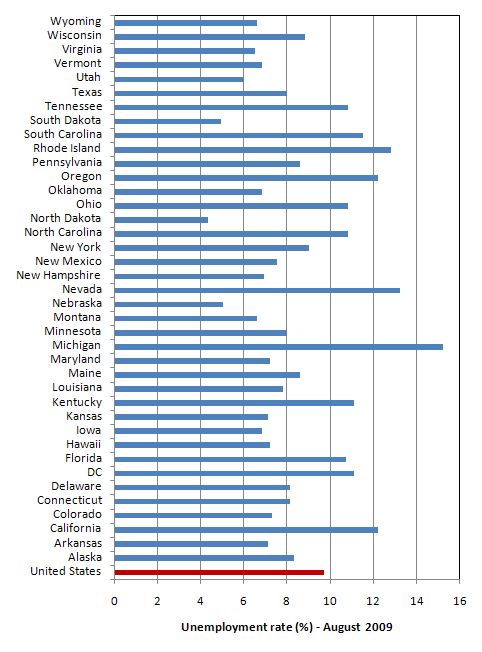
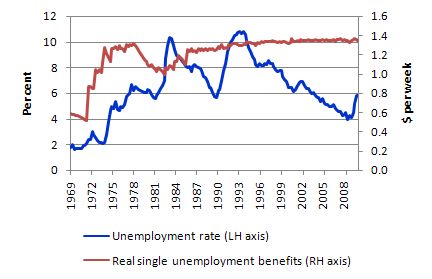


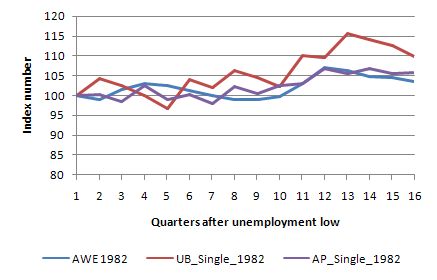
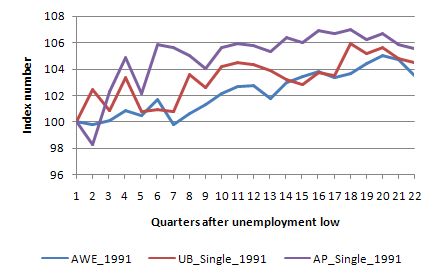
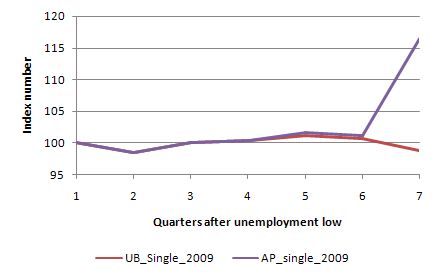
Dear Bill,
Did you include the up to $110 pf rental assistance you can get in your analysis of benefits. If you did not, you may have to adjust your “There is not very much you can buy with $32.50 a day after paying accommodation” assessment.
Regards,
Senex
Bill:
How do you calculate your index numbers?
Thanks
Vinodh
There’s an inside story on this that no doubt will all come out one day. Suffice to say that it reflects discredit on some prominent people in this government. In fact it’s a measure of Gillard’s ambition that she hasn’t done the right thing and resigned over it rather than stay bound by Cabinet solidarity.
Keep pressing them, people, because there are plenty of members of the government who feel genuine guilt over their treatment of the unemployed. They’ll give way and do what they know to be the decent thing if the pressure is strong enough.
I just did the calculations of single unemployed benefit and came out with $32.48 a day for a 365 day year.
As I previously stated, you can get up to $110 per fortnight rental assistance depending on your circumstances (it used to be only $90 [89.90 if you’re pedantic])
Assuming maximum rental assistance (accommodation pay), that’s still only $40.31 a day.
Though it does work out to be $283pw which is still short of the poverty line estimate.
Gillard is a reptile. End of story.
Dear Prof. Mitchell,
Before I give my opinion, I would like to make clear I am not an economist. I can base my conclusions, for what they are worth, only on “anecdotal evidence”, as I have very limited access to hard statistical evidence. What is more, I am probably biased in this matter, given my social extraction.
As a consequence of the above, I cannot blame anyone for taking my words with a grain of salt. Or entirely disregard them.
Having issued that warning, I believe the reason why voters accept the state of affairs you so clearly exposed, is ideological. All the neoclassical mumbo-jumbo is only a convenient rationalization used by politicians and technocrats to justify their action. And it works in the exact same way to justify the prejudices of a segment of the voting population.
A previous poster said “Keep pressing them, people, because there are plenty of members of the government who feel genuine guilt over their treatment of the unemployed”. For all I know, this poster may be right in that many members of the government feel genuine guilt over this. But when it comes to get votes, these government members know perfectly well that to “increase the dole” does not pay.
Maybe I am watching too much TV, but one can see that pensioners, for instance, receive a much more favorable coverage than the unemployed. Similar observation applies to single parents, for instance. And there are other groups who can only be described as “losers”.
Ever since the French Revolution and increasingly after the Industrial Revolution society has embraced the belief that ideal human societal organization is a “meritocracy”. In other words, you get what you deserve. This might be quite flattering for those who get a lot. But can be rather unpleasant for those who don’t.
The philosopher Alain de Botton has written an interesting book (Status Anxiety) and TV documentary series (by the same name), where he argues this point very convincingly. It is a non-academic book, though.
Thanks for your time,
Marco
Good post Marco.
You sound very informed and balanced to me.
cheers, Alan